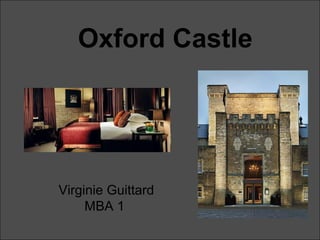
Oxford Castle History from Norman Conquest
- 1. Oxford Castle Virginie Guittard MBA 1
- 3. History Oxford Castle is a large, partly ruined Norman medieval castle situated on the west edge of Oxford in Oxfordshire, England. Oxford Castle was built by the Norman baron, Robert D'Oyly who had arrived in England with William I during the Norman Conquest of England in 1066. Oxford had been stormed during the invasion with considerable damage, and William instructed D'Oyly to build a castle to dominate the town The original moated, wooden motte and bailey castle was replaced with stone in the 11th century and played an important role in the conflict of the Anarchy.
- 4. History In the 14th century the military value of the castle diminished and the site became used primarily for county administration and for detaining prisoners. Most of the castle was destroyed during the English Civil War and by the 18th century the remaining buildings were used as Oxford's local prison. A new prison complex was built on the site from 1785 onwards and expanded in 1876; this ultimately became HM Prison Oxford. The prison closed in 1996 and was redeveloped as a hotel. Today the medieval remains of the castle, including the motte and St George's Tower, are classed as a Grade I listed building and as a Scheduled Monument.
- 5. Role as prison Oxford Castle was primarily used after the Civil War as the local prison. In the 1770s the castle was visited several times by the prison reformer John Howard, who criticised the size and quality of the establishment, including the extent of the vermin that infested the prison. Partially as a result of this critique, the decision was taken to rebuild the Oxford Prison. In the 19th century the site continued to be developed, with various new buildings constructed, including the new County Hall, the Militia Armoury; the prison itself was extended in 1876, growing to occupy most of the remaining space. In 1888 national prison reforms led to the renaming of the county prison as HM Prison Oxford.
- 6. Today The prison was closed in 1996 and the site reverted to Oxfordshire County Council . The remains of the castle are classed as a Grade I listed building and as a Scheduled Monument.Still visible is the castle motte, St George's Tower and the crypt.
- 7. Today The Oxford Prison buildings have since been redeveloped as a shopping and heritage complex, with guided tours of the historic buildings and open courtyards for markets and theatrical performances.
- 8. Today The mixed-use heritage project won the RICS Project of the Year Award 2007 The hotel brand was formed in 1994 and is named after the Château de Malmaison on the outskirts of Paris. The chain is owned by MWB Group Holdings. Their brand premise is "Hotels that dare to be different" The group also owns the Hotel du
- 9. Reviews
- 10. Reviews
- 11. Reviews